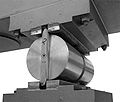Warehouse (construction)
Bearings used in construction are constructions for transferring the forces of a supporting structure to the substructure such as pillars , foundations , abutments, etc.
In terms of statics , bearings are understood symbolically (bearing symbols). Only with this abstraction is it possible to completely model the supporting structure as a static system, with the help of which, for example, the cutting forces and the support forces can be calculated and thus the bearings can be dimensioned. See: bearing (statics) .
The term storage can refer to the way in which the various bearing interact of a structure ( see: bearing (static) ). The term storage can also be used synonymously with foundation ( see also abutment (bridge construction) ).
The bearings dealt with here are usually designed both to take loads from a structure and to allow (minor) movements of the structure (to prevent the occurrence of thermal stresses due to temperature changes). A distinction must be made between these so-called abutments , which are used specifically to absorb horizontal ( shear ) forces and either transfer them into the surrounding structure or directly into the subsoil . Abutments themselves do not allow movements, but are often combined with pivot bearings ( swivel joints ) in order to allow changes in the angle of the supporting structure with respect to its foundation or storage.
A structure usually has several bearings. The number of bearings with their respective degree of freedom determines whether the structural system of the structure is externally statically determined or indefinite. A bearing with is a fixed restraint . The system then does not need any further bearings to be statically determined. (The bearing of a supporting structure could consist of a single bucket foundation .) The figure above on the right shows a single roller tilting bearing, which fixes the entire bridge horizontally and also vertically at the bearing point. But it allows twisting around a cross bolt. The figure below shows a multi-roller bridge bearing , which also enables longitudinal displacement over several transverse rollers.
Long pipelines used for the transport of temperature-variable media (water, steam) also require the longitudinal mobility of their bearings because of the change in length of the pipes associated with the temperature change.
Storage types of spatial systems
If the number of forces that can be absorbed is specified, the following types result:
- Fixed bearing on all sides ( ): cannot be moved.
- Easily slidable (movable) bearing ( ): slidable along one axis and rigid in two directions.
- (Double) movable bearing ( ): movable in two directions and rigidly mounted along one axis.
Bearing according to static requirements:
- Fixed and floating bearings, see bearings (statics)
- Unidirectional movable bearings
- Bearings that move in all directions
Bearings that allow an angle change:
- Flat slide bearings
- Tilt bearing
- Neo pot bearings ( rubber pot bearings), elastomer bearings
- Quiver bearings, trunnion or ball bearings
- Spherical bearings
Bearings that allow movement:
- Multiple roller bearings, ball bearings
- Rubber bearings, viscosity bearings
- bearings
Bearing types
- Line tilting bearings
- Roller bearings
- Point tilt bearing
- Neotopflager
- bearings
- Spherical bearings
- Elastomer bearings
- Deformation bearing
- Guide bearing
- Displacement storage for incremental launching
- In bridge construction, the bridge bearing connects the superstructure of the bridge with the substructure.
See also
literature
- Tobias Block, Helmut Eggert , Wolfgang Kauschke: Warehouses in the building industry. 3rd, completely revised Edition. Ernst & Sohn, Berlin 2013, ISBN 978-3-433-02921-3 .
Web links
Notes and individual references
- ↑ Roller bearings and accessories for pipelines hesterberg-gmbh.com
- ↑ An alternative solution is to insert omega-shaped protruding elbows or short corrugated pipes in which the change in length only leads to tolerable elastic deformation.
- ↑ Volker Wetzk: bridge bearings. 1850-1950 , Dissertation Brandenburg Technical University Cottbus 2010; PDF
- ^ Bernhard Pichler, Josef Eberhardsteiner: Structural Analysis VO - LVA no. 202.065 . Ed .: E202 Institute for Mechanics of Materials and Structures - Faculty of Civil Engineering, TU Vienna. SS 2016 edition. TU Verlag, Vienna 2016, ISBN 978-3-903024-17-5 , angle of rotation method (520 pages, shop.tuverlag.at - first edition: 2012). shop.tuverlag.at ( Memento of the original from March 13, 2016 in the Internet Archive ) Info: The archive link was inserted automatically and has not yet been checked. Please check the original and archive link according to the instructions and then remove this notice.














